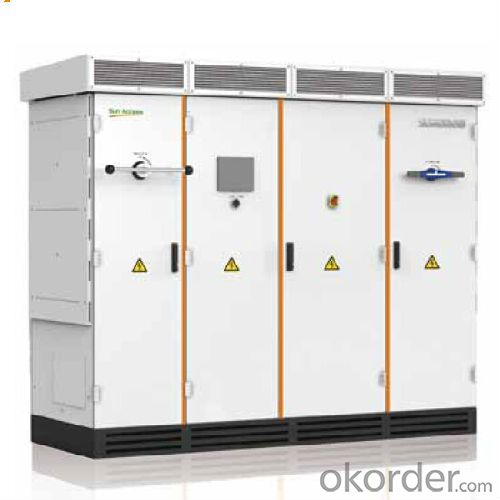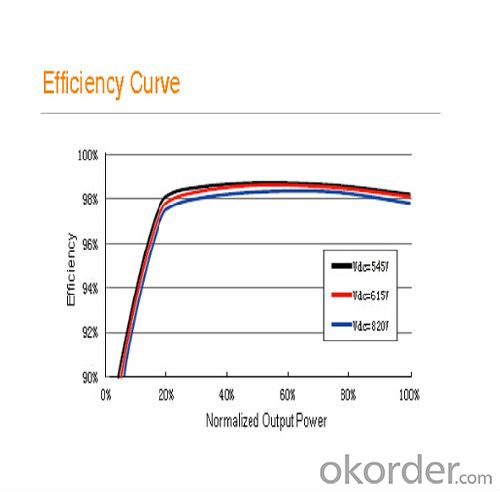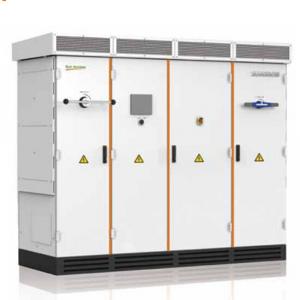Photovoltaic Grid-Connected Inverter SG750MX
- Loading Port:
- China Main Port
- Payment Terms:
- TT or LC
- Min Order Qty:
- 50 unit
- Supply Capability:
- 1000 unit/month
OKorder Service Pledge
OKorder Financial Service
You Might Also Like
1. Structure of Photovoltaic Grid-Connected Inverter SG750MX Description
A solar inverter, or PV inverter, or Solar converter, converts the variable direct current (DC) output of a photovoltaic (PV) solar panel into
autility frequency alternating current (AC) that can be fed into a commercial electrical grid or used by a local, off-grid electrical network.
It is acritical BOS–component in a photovoltaic system, allowing the use of ordinary AC-powered equipment. Solar inverters have
special functions adapted for use with photovoltaic arrays, including maximum power point tracking and anti-islanding protection.
Suitable for 50Hz/60Hz grid, could be used in Asia, North America and Europe.
2. Main Features of the Photovoltaic Grid-Connected Inverter SG750MX
• Transformerless inverter, max. efficiency of 98.7%, CEC efficiency of 98.5% for SG800MX,max. efficiency of 98.6%, CEC efficiency of 98.0% for SG750MX
• Employing a patented thermal management system, the inverter is able to operate from -13˚F to 140˚F (-25˚C to 60˚C), and up to 19,600’ (6,000 m).
• High power density, small equipment footprint
• DC disconnect, AC circuit breaker, separate DC & AC cabinets
• Max. DC input voltage is 1000V, can be mounted on a skid or an e-house, giving maximum design flexibility and lowering installation costs
• Continuous active power control
• Advanced grid support functionality, meet grid requirements around the world
• Full remote and local power curtailment, PF, HVRT, LVRT, FRT controls via ModBus & Ethernet
• Designed for 20+ years of operating life
• NEMA4X electronics cabinet
3. Photovoltaic Grid-Connected Inverter SG750MX Images


4. Photovoltaic Grid-Connected Inverter SG750MX Specification
Input Side Data |
|
Max. PV input power | 850kW |
Max. PV input voltage | 1000V |
Start voltage | 520V |
Min. operation voltage | 500V |
Max. PV input current | 1600A |
MPP voltage range | 500~820V |
No. of DC inputs | 1, 6-12 |
PV array configuration | Negative ground (standard), Floating or Positive Ground (optional) |
Output Side Data |
|
Nominal AC output power | 750kW |
Max. AC output apparent power | 825kVA |
Max. AC output current | 1512A |
THD | <3% (nominal power) |
Nominal AC voltage | 315V |
AC voltage range | 277~347Vac |
Nominal grid frequency | 50/60Hz |
Grid frequency range | 47~52Hz/57~63Hz |
Power factor | >0.99@default value at nominal power, adj. 0.8 overexcited~0.8 underexcited |
Isolated transformer | No |
DC current injection | <0.5 % In |
Efficiency |
|
Max. efficiency | 98.60% |
European efficiency | 98.30% |
CEC efficiency | 98.00% |
Protection |
|
Input side disconnection device | DC load switch |
Output side disconnection device | Breaker |
DC overvoltage protection | Yes |
AC overvoltage protection | Yes |
Grid monitoring | Yes |
Ground fault monitoring | Optional |
Over temperature protection | Yes |
Insulation monitoring | Optional |
General Data |
|
Dimensions(W×H×D) | 2598x2164x1000mm |
Weight | 2340kg |
Operating ambient temperature range | -25~+60℃(>55℃ derating) |
Noise emission | <70dB |
Night power consumption | <100W |
External auxiliary supply voltage | 480/600V(3/N/PE) |
Cooling method | Temperature controlled air-cooling |
Ingress protection rating | NEMA 3R(IP54) |
Allowable relative humidity range | 0~95% no condensing |
Max. operating altitude | 6000m (>3000m derating) |
Fresh air consumption | 4425 m³/h |
Display | LCD |
Communication | RS485/Modbus, Ethernet(Opt.) |
5. FAQ of Photovoltaic Grid-Connected Inverter SG750MX
Q1. What is the difference between inverter and solar inverter?
A1. Inverter only has AC inpput, but solar inverter both connect to AC input and solar panel, it saves more power.
Q2. What is the difference between MPPT&PWM?
A2. MPPT has higher efficiency, it can track the max power point and won't waste energy.
- Q:What is the power factor of a solar inverter?
- The power factor of a solar inverter is a measure of how effectively it converts the DC power generated by solar panels into AC power that can be used by electrical devices. A high power factor indicates efficient conversion, while a low power factor signifies energy losses.
- Q:How does a solar inverter affect the overall system reliability?
- A solar inverter plays a crucial role in enhancing the overall system reliability of a solar power system. It converts the direct current (DC) generated by solar panels into alternating current (AC) that can be used to power household appliances and feed excess energy into the grid. By efficiently managing and controlling the flow of electricity, a reliable solar inverter ensures smooth operation of the entire system, preventing power fluctuations, voltage surges, and other electrical issues. Additionally, advanced features like anti-islanding protection and monitoring capabilities enable early detection and prevention of potential faults, further enhancing the system's reliability and performance.
- Q:How does a solar inverter handle power surges or fluctuations?
- A solar inverter handles power surges or fluctuations by regulating the flow of electricity. It monitors the incoming power and adjusts the voltage and frequency to match the requirements of the connected devices. In case of power surges, the inverter has built-in protection mechanisms such as surge suppressors or voltage regulators to prevent any damage to the system. Additionally, some inverters feature advanced technologies like Maximum Power Point Tracking (MPPT) that optimize the solar panel's performance and enable better handling of fluctuations in power output.
- Q:Can a solar inverter be connected to a generator?
- Yes, a solar inverter can be connected to a generator. This connection allows the solar inverter to work in conjunction with the generator, utilizing both the solar energy and the generator power to meet the electrical requirements of a system.
- Q:What is the role of an anti-islanding function in a solar inverter?
- The role of an anti-islanding function in a solar inverter is to ensure the safety of electrical grid workers by preventing the solar inverter from continuing to generate and supply power to the grid during a power outage. This function is crucial as it helps avoid the risk of injury or damage to utility workers who may be repairing or working on the grid. By detecting the loss of grid power, the anti-islanding function quickly disconnects the solar inverter from the grid, preventing any power feedback and ensuring that the grid remains stable and isolated.
- Q:Can a solar inverter be used with different types of power control devices?
- Yes, a solar inverter can be used with different types of power control devices. Solar inverters are designed to convert the direct current (DC) generated by solar panels into alternating current (AC) that can be used to power household appliances and other electrical devices. They can be integrated with various power control devices such as charge controllers, battery banks, and grid-tie systems to optimize the energy output and manage the flow of electricity efficiently.
- Q:Can a solar inverter be used with a solar-powered lighting system?
- Yes, a solar inverter can be used with a solar-powered lighting system. The solar inverter is responsible for converting the direct current (DC) generated by the solar panels into alternating current (AC) that can be used to power the lighting system. It ensures efficient energy conversion and ensures compatibility between the solar panels and lighting system.
- Q:Can a solar inverter be used in a mobile or portable solar system?
- Yes, a solar inverter can be used in a mobile or portable solar system. In fact, it is a crucial component that converts the direct current (DC) generated by the solar panels into alternating current (AC) that can be used to power various devices and appliances. Portable solar systems often include a built-in inverter, allowing them to provide convenient and clean energy on the go.
- Q:Photovoltaic grid-connected inverter problem
- But Baidu Encyclopedia clearly pointed out: the zero line is the secondary side of the transformer leads the neutral point of the line, and the phase line constitutes a circuit for power supply equipment.
- Q:Can a solar inverter be used with a smart home automation system?
- Certainly! A smart home automation system can indeed work together with a solar inverter. Nowadays, many solar inverters come with communication capabilities built-in, like Wi-Fi or Ethernet connectivity. This means that they can easily be integrated into a smart home automation system. This integration allows homeowners to remotely monitor and control their solar power production and usage using a smartphone app or a central control panel. By having a smart home automation system, users can keep track of real-time energy generation, make adjustments to settings, and receive notifications about system performance or any potential issues. This integration not only enhances the convenience and efficiency of managing solar power but also enables better optimization and synchronization with other smart devices and appliances in the household.
1. Manufacturer Overview |
|
|---|---|
| Location | |
| Year Established | |
| Annual Output Value | |
| Main Markets | |
| Company Certifications | |
2. Manufacturer Certificates |
|
|---|---|
| a) Certification Name | |
| Range | |
| Reference | |
| Validity Period | |
3. Manufacturer Capability |
|
|---|---|
| a)Trade Capacity | |
| Nearest Port | |
| Export Percentage | |
| No.of Employees in Trade Department | |
| Language Spoken: | |
| b)Factory Information | |
| Factory Size: | |
| No. of Production Lines | |
| Contract Manufacturing | |
| Product Price Range | |
Send your message to us
Photovoltaic Grid-Connected Inverter SG750MX
- Loading Port:
- China Main Port
- Payment Terms:
- TT or LC
- Min Order Qty:
- 50 unit
- Supply Capability:
- 1000 unit/month
OKorder Service Pledge
OKorder Financial Service
Similar products
New products
Hot products
Related keywords






























